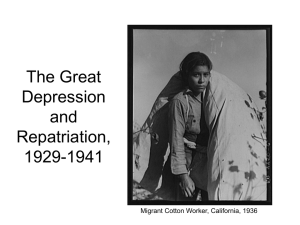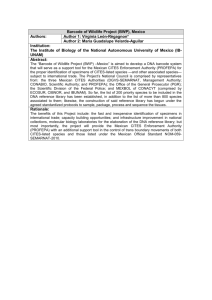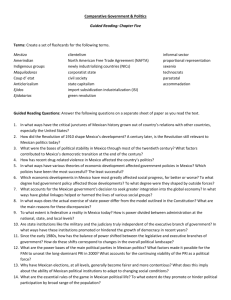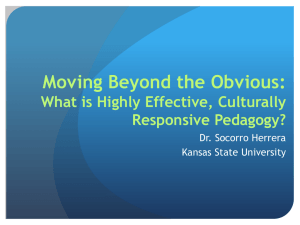File
advertisement
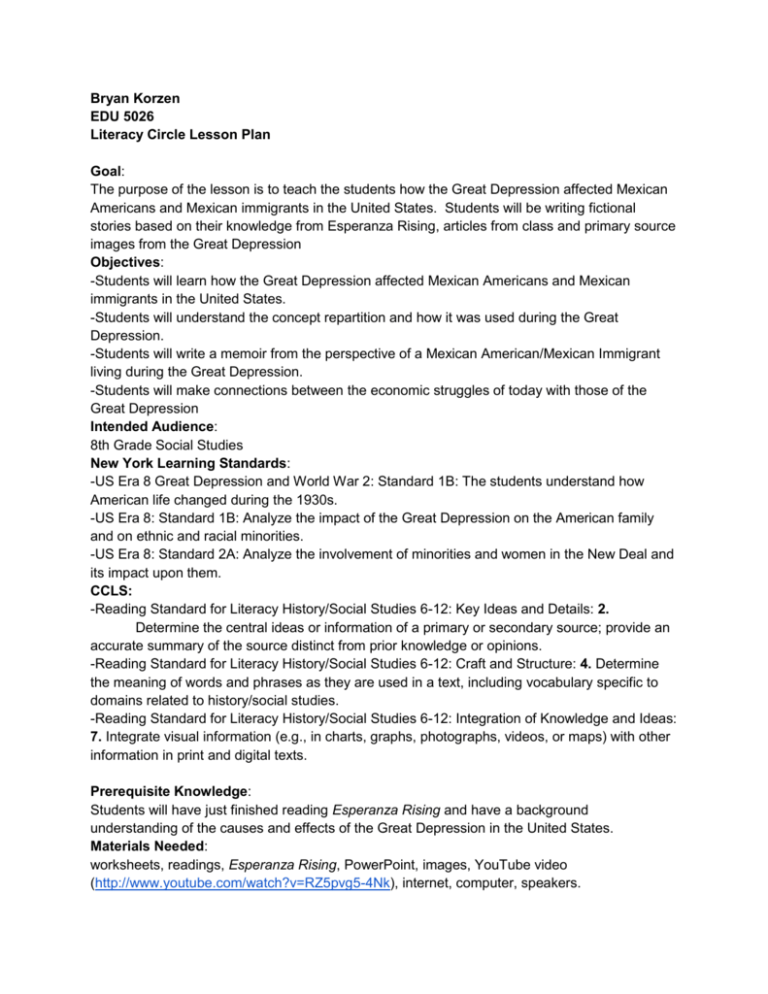
Bryan Korzen EDU 5026 Literacy Circle Lesson Plan Goal: The purpose of the lesson is to teach the students how the Great Depression affected Mexican Americans and Mexican immigrants in the United States. Students will be writing fictional stories based on their knowledge from Esperanza Rising, articles from class and primary source images from the Great Depression Objectives: -Students will learn how the Great Depression affected Mexican Americans and Mexican immigrants in the United States. -Students will understand the concept repartition and how it was used during the Great Depression. -Students will write a memoir from the perspective of a Mexican American/Mexican Immigrant living during the Great Depression. -Students will make connections between the economic struggles of today with those of the Great Depression Intended Audience: 8th Grade Social Studies New York Learning Standards: -US Era 8 Great Depression and World War 2: Standard 1B: The students understand how American life changed during the 1930s. -US Era 8: Standard 1B: Analyze the impact of the Great Depression on the American family and on ethnic and racial minorities. -US Era 8: Standard 2A: Analyze the involvement of minorities and women in the New Deal and its impact upon them. CCLS: -Reading Standard for Literacy History/Social Studies 6-12: Key Ideas and Details: 2. Determine the central ideas or information of a primary or secondary source; provide an accurate summary of the source distinct from prior knowledge or opinions. -Reading Standard for Literacy History/Social Studies 6-12: Craft and Structure: 4. Determine the meaning of words and phrases as they are used in a text, including vocabulary specific to domains related to history/social studies. -Reading Standard for Literacy History/Social Studies 6-12: Integration of Knowledge and Ideas: 7. Integrate visual information (e.g., in charts, graphs, photographs, videos, or maps) with other information in print and digital texts. Prerequisite Knowledge: Students will have just finished reading Esperanza Rising and have a background understanding of the causes and effects of the Great Depression in the United States. Materials Needed: worksheets, readings, Esperanza Rising, PowerPoint, images, YouTube video (http://www.youtube.com/watch?v=RZ5pvg5-4Nk), internet, computer, speakers. Procedure: 1. Do Now Responses: What do you think causes an economic crisis (such as the Great Depression or the Recession of recent) 2. Discussion: Economic discussion hearing the ideas of the students. 3. Pair work time: In pairs, students will read their articles and answer the related questions 4. Cooperative group work time: After the readings and questions are gone over. Students will get into groups of 3-5 (depending on class size). Using the articles and chosen images, students will develop a memoir or a letter to a family member describing life as a Mexican American or Mexican Immigrant during the Great Depression 5. Presentations: Groups will present their memoirs or letters 6. End Discussions: Recapping the lesson further discussing how economies fail and struggle. Important to make connections to today’s economic situation and the outsourcing of American Industries. Lesson Plan: -Aim: How were Mexican Americans and Mexican Immigrants living in the United States affected by the Great Depression? Motivation: What caused an economy to fall apart? How can we connect today’s economic situation to the Great Depression? Questions: What is repartition? Why did they use this policy during the Great Depression? Why do you think they targeted minority immigrants? Did the United States government under FDR make the right decision? Does a policy like repartition exist today? What about outsourcing of American Industries? Summary: Students will be using articles and primary source images from the Great Depression to develop a memoir or letter from the perspective of a Mexican American or Mexican Immigrant during the Great Depression. Application: Students will be applying the content knowledge of the Great Depression time period and trying to make connection with current economic struggles today. Adaptations: For most groups, students will be paired with someone using a different articles. An adaptation for some students will be to pair them up with someone of the same article and have them focus on answering those questions. For cooperative group work, some students may be given memoir ideas that could be used in their story. Assessment: There will be choice assignments for homework. Students choose one. 1. Choose 10 words from the articles read in class. Define each word and write a sentence including that word. 2. Find an article on outsourcing of american industries and write a one page paper on the topic. 3. Write a poem about how Mexican Americans/Mexican Immigrants were affected by the Great Depression. Name: _______________________________ Date: ____________________ Mexican Americans During the Great Depression Directions: With a partner, work together to answer the following questions. Use complete sentences. 1. What are 2 reasons that Mexicans immigrate to the United States in the early 1900s? 2. Describe at least 2 discriminations that Mexican immigrants and Mexican Americans faced in the United States? 3. What is repatriation? What was the purpose of repatriation programs? 4. Were Mexican immigrants and Mexican Americans looked at differently by state and local governments during repatriation? 5. Did Mexicans in the United States receive support from the Federal Government under the New Deal? Why or Why not? Name: ________________________________ Date: ______________ Stories of Mexican Americans during the Great Depression Directions: Each group shall take one or two images from the front of the table and use these images to tell a story. Use the readings as background information to help paint the picture of what life was like as a Mexican American living during the Great Depression. These people faced many hardships, discriminations as well as repatriation from the Federal Government. The structure of your story can include a memoir, poem, a letter to a friend or relative or a cartoon. Here are some ideas that can be incorporated in your story. Why did they immigrate to America? What was life like for these people living in America? What were their living and working conditions? How were they coping with discrimination from American Society? Was life actually better in America compared to Mexico? Were they being threatened with repatriation? Mexican Americans and the Great Depression by Steven Mintz In February 1930 in San Antonio, Tex., 5000 Mexicans and Mexican Americans gathered at the city's railroad station to depart the United States for settlement in Mexico. In August, a special train carried another 2000 to central Mexico. Most Americans are familiar with the forced relocation in 1942 of 112,000 Japanese Americans from the West Coast to internment camps. Far fewer are aware that during the Great Depression, the Federal Bureau of Immigration (after 1933, the Immigration and Naturalization Service) and local authorities rounded up Mexican immigrants and naturalized Mexican American citizens and shipped them to Mexico to reduce relief roles. In a shameful episode, more than 400,000 repatriodos, many of them citizens of the United States by birth, were sent across the U.S.-Mexico border from Arizona, California, and Texas. Texas' Mexican-born population was reduced by a third. Los Angeles also lost a third of its Mexican population. In Los Angeles, the only Mexican American student at Occidental College sang a painful farewell song to serenade departing Mexicans. Even before the stock market crash, there had been intense pressure from the American Federation of Labor and municipal governments to reduce the number of Mexican immigrants. Opposition from local chambers of commerce, economic development associations, and state farm bureaus stymied efforts to impose an immigration quota, but rigid enforcement of existing laws slowed legal entry. In 1928, United States consulates in Mexico began to apply with unprecedented rigor the literacy test legislated in 1917. After President Hoover appointed William N. Doak as secretary of labor in 1930, the Bureau of Immigration launched intensive raids to identify aliens liable for deportation. The secretary believed that removal of undocumented aliens would reduce relief expenditures and free jobs for native-born citizens. Altogether, 82,400 were involuntarily deported by the federal government. Federal efforts were accompanied by city and county pressure to repatriate destitute Mexican American families. In one raid in Los Angeles in February 1931, police surrounded a downtown park and detained some 400 adults and children. The threat of unemployment, deportation, and loss of relief payments led tens of thousands of people to leave the United States. The New Deal offered Mexican Americans a little help. The Farm Security Administration established camps for migrant farm workers in California, and the CCC and WPA hired unemployed Mexican Americans on relief jobs. Many, however, did not qualify for relief assistance because as migrant workers they did not meet residency requirements. Furthermore, agricultural workers were not eligible for benefits under workers' compensation, Social Security, and the National Labor Relations Act. https://www.gilderlehrman.org/history-by-era/great-depression/resources/mexican-americansand-great-depression Depression Era: 1930s: Repatriation for Mexican & Filipino Farm Workers Mexican and Mexican American migrant farm workers expected conditions like those pictured above as they sought farm work in California and other states in the early 1900s. At that time, the Mexican Revolution and the series of Mexican civil wars that followed pushed many Mexicans to flee to the United States. Many U.S. farm owners recruited Mexicans and Mexican Americans because they believed that these desperate workers would tolerate living conditions that workers of other races would not. Mexican and Mexican American workers often earned more in the United States than they could in Mexico's civil war economy, although California farmers paid Mexican and Mexican American workers significantly less than white American workers. By the 1920s, at least three quarters of California's 200,000 farm workers were Mexican or Mexican American. As this rapid shift of Mexico's working population occurred, the first labor agreement between the United States and Mexico was formed. Mexico required that U.S. farm owners provide legal contracts for all Mexican workers guaranteeing conditions such as wages and work schedules. The U.S. government, in turn, enforced the border between the United States and Mexico, checking that all Mexican immigrants had the proper work contract so they would not be exploited. As the Great Depression took a toll on California's economy during the 1930s, however, Mexicans and Mexican Americans became targets for discrimination and removal. White government officials claimed that Mexican immigrants made up the majority of the California unemployed. White trade unions claimed that Mexican immigrants were taking jobs that should go to white men. In reality, a new supply of white refugees desperate for jobs was flooding California from the Midwest, making up the majority of the unemployed. At the same time that wages were dropping due to the new white refugee labor, established Mexican and Mexican American farm workers had become a threat by banding together, often with other non-whites, and organizing strikes to protest lowered wages and worsening living conditions. Agriculture in the United States was crippled due to the ongoing Dust Bowl drought in the Midwest, while California was relatively untouched - the farm owners had a chance to profit immensely from the supply of cheap labor, but not if these protests succeeded. California state and local governments responded to white farm owner pressure and implemented "repatriation" plans to send Mexican immigrants back to Mexico in busloads and boxcars. Many Mexican Americans were also sent out of the United States under these programs, there being no differentiation between Mexicans and Mexican American U.S. citizens. Mexican American U.S. citizens who were children at the time were also deported to Mexico along with their Mexican parents. Despite a hundred years of effort, economic exploitation of farm workers of all races continues to this day in California and across the United States. As long as farm owners can continue forcing people to live in such conditions, the farm workers' struggle seems doomed to continue. http://www.museumca.org/picturethis/timeline/depression-era-1930s/migrant-farm-workers/info





